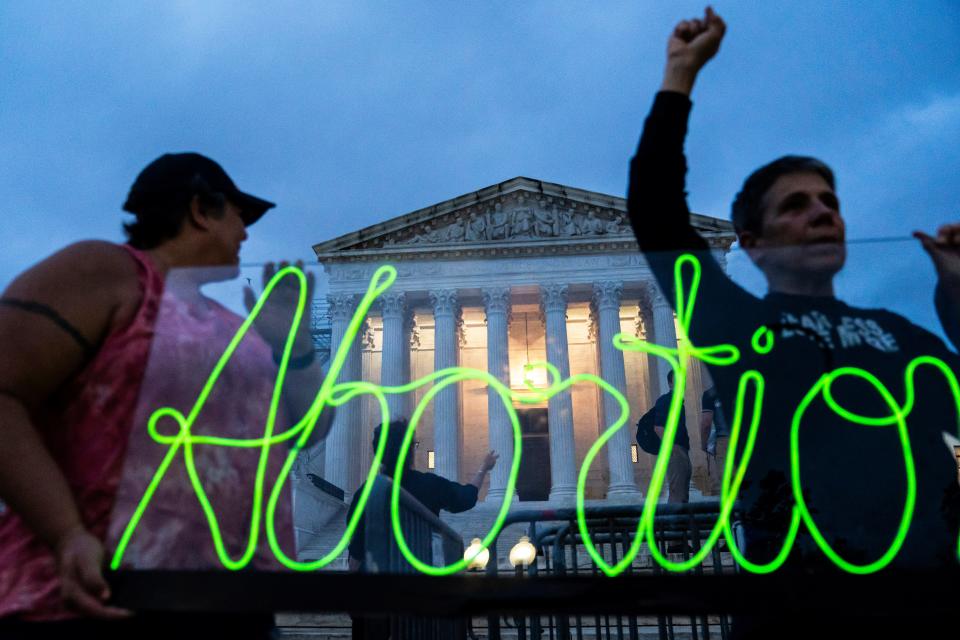Bellwether? Ohio voters back abortion rights amendment in a test case for other states
Sweeping support for a proposed Ohio constitutional amendment enshrining abortion rights spotlights the potential power of the issue to drive voter turnout and affect races up and down the ballot, even in Republican-leaning states.
A new USA TODAY Network/Suffolk University survey of Ohio showed the amendment guaranteeing access to reproductive services backed by a double-digit margin, 58%-32%. Significant support crossed partisan lines, including a third of Republicans and a stunning 85% of independent women, a key group of persuadable voters.
The poll of 500 likely voters in Ohio, conducted by landline and cellphone from July 9 to 12, has a margin of error of plus or minus 4.4 percentage points for the full sample.
The battle in Ohio, the only state likely to have an abortion measure on the ballot in November's off-year election, is being watched by activists nationwide who are considering a push for state-based initiatives in the next election cycle to codify or restore abortion rights. That could include swing states such as Arizona and reliably red ones like Florida, Missouri and South Dakota.
Ohio stands as a test case.

The first hurdle: How many votes needed to pass it?
"For sure, I think folks are really paying attention," said Heather Shumaker, director of state abortion access for the National Women's Law Center, which supports the amendment. That's especially true in states where Republican-controlled state governments have imposed strict limits on abortions in the year since the Supreme Court overturned Roe v. Wade. "We know that ballot measures have emerged as one of the most promising strategies to preserve abortion access."
Opponents of abortion are also watching Ohio for lessons on how to combat the initiatives. "I certainly anticipate other states to be looking at us and the model we used," said Amy Natoce of Protect Women Ohio, a coalition opposing the proposal. They describe the measure as "anti-parent," arguing it undermines the authority of parents to make decisions about abortion and gender assignment issues for their minor children.
A special election on Aug. 8 could change the prospects for passage.
Now, ballot measures in Ohio need a simple majority, 50% plus one, to amend the state constitution. Under the proposal being voted on next month, the bar would be raised to 60%. Support in the new survey for the abortion-rights measure, at 58%, would fall just short of that level.
In the poll, Ohioans opposed raising the threshold by more than 2-1, 57%-26%.
Ohio Secretary of State Frank LaRose faces a deadline Tuesday to announce if proponents gathered enough valid signatures to put the abortion rights measure on the November ballot as well as a proposal to legalize the recreational use of marijuana by adults.
Who supports the abortion amendment in Ohio?

The proposed amendment to the Ohio constitution states that "every individual has a right to make and carry out one's own reproductive decisions, including but not limited to decisions on contraception, fertility treatment, continuing one's own pregnancy, miscarriage care, and abortion." Abortion could be banned after viability when a fetus could survive outside the womb.
After being read the ballot measure's language, women surveyed supported the measure by more than 2-1, 64%-28%. Men backed it by 50%-37%.
White respondents backed it by 57%-34% and minority respondents by 66%-24%.
A majority of those at all levels of education expressed support, from those with no more than a high school diploma (52%-39%) to those with post-graduate degrees (65%-26%).
Support also spanned all age groups. It was strongest among young voters; those 18 to 34 years old backed it by close to 3-1, 69%-25%. Seniors 65 and older comprised the age group who supported it by the smallest margin, 48%-40%.
The breadth of backing across demographic divisions is notable. So are the views across party lines. The measure was endorsed not only by the overwhelming majority of Democrats, 81%-14%, but also among independents by 3-1, 68%-22%. Support among independent women was 85%-12%, a bit higher than even among Democratic women, 81%-14%.
Women who aren't firmly aligned with either party have emerged as one of the most decisive groups of voters in recent elections, including in the GOP's disappointing performance in last year's midterm elections. Abortion access was one of the main issues Democratic candidates hammered.
"The general public in Ohio still likes their local Republican lawmakers, but when it comes to extreme positions against abortion rights, they are reeling them in," said David Paleologos, director of the Suffolk University Political Research Center. "Even Republican voters have daughters, nieces, and granddaughters who may be facing decisions right now on abortion, contraception, or fertility treatment. So for some of these voters, it's not politics, it's personal."
In the USA TODAY survey, 32% of Republicans supported the amendment, 57% opposed it. There was no meaningful statistical difference between Republican women (31%-58%) and Republican men (33%-56%).
Ballot measures can generate turnout, affecting the outcome of other elections. The proposals in Ohio on both abortion rights and marijuana legalization could encourage younger and more liberal voters to go to the polls.
In 2004, strategists for President George W. Bush encouraged Ohio Republicans to put a proposal banning same-sex marriage on the ballot, a tactic they calculated would energize conservative evangelicals to vote. It passed easily, and Bush's victory in Ohio − so close it wasn't clear until the morning after the election − was decisive in his defeat of Democrat John Kerry.
For Republican presidential contenders, a potential conundrum
More than a third of voters who backed former President Donald Trump over President Joe Biden in a hypothetical 2024 matchup (34%) and those who backed Florida Gov. Ron DeSantis (36%) also supported the abortion amendment, the USA TODAY/Suffolk poll found.
DeSantis now claims the lion's share of Republican primary voters who support the amendment − 32% of them, compared with 15% who support Trump and 21% who are undecided. That's the case even though DeSantis in April signed a ban on abortions in Florida after six weeks of pregnancy; the law is now blocked as a court challenge continues.
DeSantis' strength among voters who back the amendment seems to indicate either that they aren't aware of his action on abortion or that the issue is not enough to sway their support for him.
In Ohio, Republican Gov. Mike DeWine in 2019 signed a "Heartbeat Bill" that effectively criminalizes abortion at six weeks, when cardiac activity can be detected in the embryo. The Ohio Supreme Court is now considering whether to allow the law to go into effect.
This article originally appeared on USA TODAY: Ohioans back abortion rights amendment, a test case for other states

